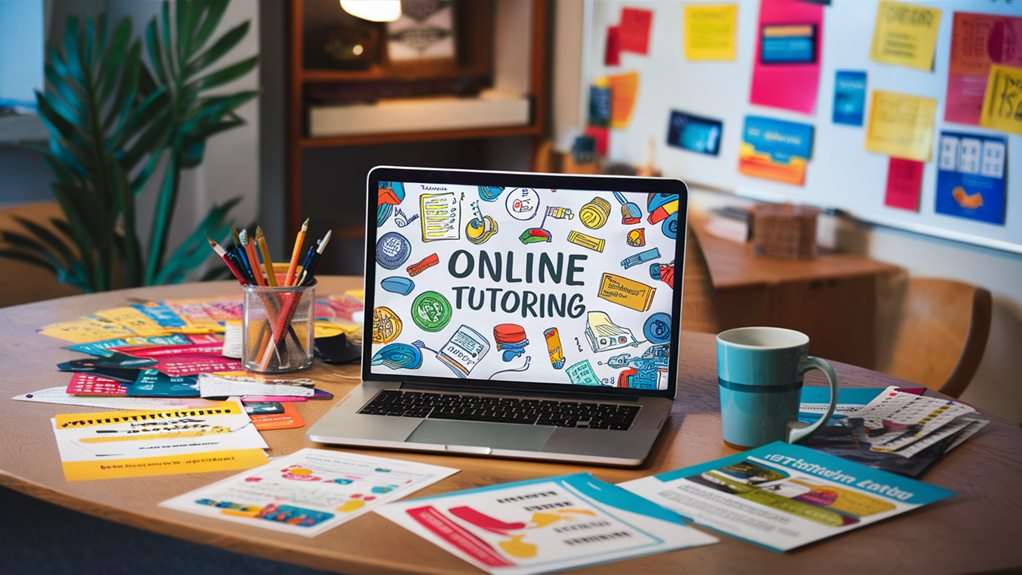Becoming a remote online tutor requires a combination of skills and tools designed to foster effective learning. You'll need strong communication and interpersonal skills to engage students and create a supportive environment. It's essential to have a reliable tech setup, including video conferencing tools and interactive platforms. Adaptable teaching strategies, such as multimedia resources and timely feedback, enhance student motivation and success. Additionally, marketing your unique skills is pivotal to attract students. By investing in continuous learning and adapting to new trends, you position yourself for success. Discovering more about specific strategies can further enhance your tutoring journey.
Key Takeaways
- Build a strong educational background and relevant certifications to establish credibility as a remote online tutor.
- Develop excellent communication and interpersonal skills to engage students effectively in an online setting.
- Utilize reliable technology tools, such as video conferencing and interactive whiteboards, to enhance the learning experience.
- Implement diverse teaching strategies, including multimedia resources and interactive activities, to cater to different learning styles.
- Focus on continuous improvement by seeking feedback, joining communities, and staying updated on educational trends and tools.
Understanding the Role of a Tutor

Understanding the role of a tutor is vital for anyone looking to succeed in the field of remote online tutoring. As a tutor, you're not just a source of knowledge; you're a guide who fosters a supportive learning environment. Your primary aim is to enhance student engagement, ensuring that learners feel motivated and actively participate in their educational journey. Joining a community that offers exclusive resources can also provide valuable insights into effective tutoring strategies.
To achieve this, you'll need to employ effective teaching techniques tailored to individual learning styles. Whether it's using interactive tools for visual learners or engaging in thought-provoking discussions for auditory learners, adapting your approach is essential. By utilizing diverse teaching methods, you create a vibrant space where students feel valued and understood.
Moreover, fostering student engagement goes beyond just delivering content. It involves building relationships based on trust and communication. When students feel comfortable, they're more likely to share their struggles and successes, creating a collaborative atmosphere that enriches the learning experience. Regular feedback and encouragement can significantly enhance this connection, making students feel supported and more invested in their progress.
Required Qualifications and Skills

To effectively guide your students as a remote online tutor, having the right qualifications and skills is essential. Your educational background plays a pivotal role in establishing credibility and expertise. While a degree in education or a specific subject area can enhance your profile, it's not always obligatory. What matters is your ability to convey knowledge and foster understanding. Consider any relevant certifications or training that can bolster your qualifications and demonstrate your dedication to your craft.
Equally significant are your communication skills. As a remote tutor, you'll be engaging with students through screens, making it crucial to articulate concepts clearly and effectively. Being able to adapt your communication style to meet the diverse needs of your students fosters a sense of belonging and connection. Active listening also comes into play here; understanding students' questions and concerns allows you to respond appropriately and create a supportive learning environment.
Moreover, consider your interpersonal skills. Building rapport with students can profoundly impact their learning experience. Empathy, patience, and encouragement go a long way in helping students feel valued and understood.
Lastly, don't underestimate the importance of being adaptable. The online tutoring landscape is dynamic, and the ability to adjust your teaching methods to suit different learning styles will enhance your effectiveness. By focusing on these qualifications and skills, you won't only empower your students but also grow as a remote online tutor.
Essential Tech Tools for Tutoring

What essential tech tools do you need to make your remote tutoring sessions effective? To create a successful virtual classroom, you'll want to equip yourself with a few key resources that enhance both teaching and learning experiences.
First and foremost, a reliable video conferencing platform is vital. Tools like Zoom or Google Meet not only facilitate face-to-face interaction but also support screen sharing, enabling you to present materials seamlessly.
Next, consider integrating an interactive whiteboard into your sessions. This tool allows you to engage students actively by drawing, illustrating concepts, or solving problems in real time. Students can also participate by writing or drawing on the board, making the learning experience more dynamic and collaborative.
Additionally, invest in a good microphone and webcam. Clear audio and video quality are necessary for maintaining connection and ensuring that your students understand your instructions. You might also explore platforms that offer built-in features for quizzes and polls, promoting engagement and instant feedback.
Effective Online Teaching Strategies

Effective online teaching strategies are essential for creating engaging and productive learning environments. As a remote online tutor, you want to foster student engagement and make sure that your sessions are both dynamic and effective. Here are some strategies to help you achieve that:
- Incorporate Interactive Activities: Use tools like quizzes, polls, or breakout rooms to encourage participation. These activities can break the ice and keep students actively engaged in the learning process.
- Utilize Multimedia Resources: Leverage videos, infographics, and interactive simulations to cater to different learning styles. Visual and auditory elements can enhance understanding and retention, making the content more relatable.
- Encourage Collaboration: Foster a sense of community by having students work together on projects or discussions. Collaborative learning not only boosts student engagement but also builds a supportive environment where learners feel connected.
- Provide Timely Feedback: Regularly assess students' progress and give constructive feedback. This not only helps them understand their strengths and weaknesses but also shows that you care about their learning journey.
Creating a Productive Learning Environment

While creating a productive learning environment may seem challenging in a virtual setting, it's important for student success. You can foster this environment by intentionally organizing your schedule and incorporating engaging activities. Structure brings clarity, which helps students feel more comfortable and focused.
Start by setting clear time blocks for each session. This not only helps you manage your time but also signals to your students that you value their learning. Consistency in your scheduling creates a sense of predictability, allowing students to mentally prepare and engage more effectively. Encourage your students to follow a similar routine, as this can enhance their focus and commitment.
In addition to a well-organized schedule, engaging activities are vital for maintaining student interest. Use a variety of methods such as interactive quizzes, group discussions, or multimedia presentations to diversify the learning experience. Incorporating these activities not only keeps things lively but also bolsters collaboration and encourages students to connect with one another.
Don't forget to solicit feedback from your students about which activities they find most engaging. This practice not only helps you refine your teaching methods but also fosters a sense of belonging and community among your learners. By being responsive to their needs, you create an inclusive atmosphere that values each student's contribution.
Building Strong Student Relationships

A productive learning environment sets the stage for building strong student relationships, which are crucial for enhancing the overall learning experience. When you connect with your students, you foster trust and engagement that can greatly boost their motivation and learning outcomes. Here are some effective strategies to help you build these essential relationships:
- Utilize communication techniques: Maintain open lines of communication through regular check-ins. Use video calls, messages, or emails to show that you care about their progress and well-being.
- Adopt a personalized approach: Tailor your lessons to suit each student's unique learning style, interests, and goals. This not only makes learning more relevant but also shows that you value their individuality.
- Encourage feedback: Create an environment where your students feel comfortable sharing their thoughts. Ask for feedback on your teaching methods and adjust accordingly. This highlights that you're invested in their learning journey.
- Celebrate achievements: Acknowledge both small and notable accomplishments. Whether it's mastering a challenging concept or improving a skill, recognizing their efforts builds confidence and strengthens your bond.
Marketing Yourself as a Tutor

Marketing yourself as a tutor requires a strategic approach that showcases your unique skills and expertise. To effectively attract students, you need a solid branding strategy that communicates who you're and what you offer. Start by identifying your niche—whether it's math, language arts, or test prep—and tailor your messaging to resonate with your target audience. This clarity will help you stand out in a crowded market.
Building a strong online presence is essential in today's digital world. Create a professional website that highlights your qualifications, teaching philosophy, and testimonials from previous students. Incorporate engaging content, such as blog posts or videos, that demonstrate your expertise and teaching style. This not only builds trust but also enhances your visibility in search engines.
Leverage social media to connect with potential students and their parents. Platforms like Facebook, Instagram, and LinkedIn can amplify your reach and help you foster a sense of community. Share success stories, tips, and resources that resonate with your audience. You can also join relevant groups or forums to engage with others in the education field, which can boost your credibility.
Networking is another key component of marketing yourself effectively. Attend webinars, workshops, or local events to meet fellow educators and potential clients. By actively participating in these communities, you'll create connections that can lead to referrals.
Setting Your Rates and Policies

Determining your rates and policies is essential for establishing a successful tutoring business. Your pricing strategy not only reflects your expertise but also influences how potential clients perceive your services. To effectively set your rates and payment policies, consider the following steps:
- Research Market Rates: Look into what other tutors in your niche are charging. Understanding the competitive landscape will help you position your pricing effectively.
- Assess Your Experience: Factor in your qualifications and experience. If you have specialized skills or advanced degrees, you might justify higher rates.
- Decide on a Pricing Model: Choose between hourly rates, package deals, or subscription-based pricing. Each model has its advantages; consider what aligns best with your teaching style and client needs.
- Establish Clear Payment Policies: Define your payment methods and terms. Consider offering discounts for upfront payments or multiple sessions.
Make sure to communicate your cancellation and refund policies to avoid misunderstandings.
Continuous Learning and Improvement

Once you've established your rates and policies, the next step is to focus on continuous learning and improvement to enhance your tutoring practice. This commitment not only elevates your skill development but also enriches the learning experience for your students.
Staying updated with the latest educational resources can help you refine your techniques and adapt to diverse learning styles. Consider enrolling in online courses or attending webinars focused on tutoring strategies. These platforms often provide insights into new methodologies and technologies that can make your sessions more engaging.
You might find that integrating interactive tools or gamified learning can greatly enhance student motivation and retention. Additionally, joining online communities or forums gives you a sense of belonging. Here, you can exchange ideas, seek advice, and share experiences with fellow tutors.
This collaborative environment encourages growth and innovation, ensuring you're not progressing your journey alone. Remember to solicit feedback from your students regularly. Their input can highlight areas where you excel and where you might need to improve.
Embracing constructive criticism fosters a mindset of continuous improvement that directly benefits your practice.
Frequently Asked Questions
How Do I Find My First Online Tutoring Clients?
To find your first online tutoring clients, start by developing effective marketing strategies. Utilize social media platforms to showcase your expertise and attract potential students. Engage in client outreach by joining forums or groups related to your subject area; this builds connections and trust. Consider offering free introductory sessions to entice interest.
What Subjects Are in High Demand for Online Tutoring?
When you're diving into the dynamic world of online tutoring, you'll discover that popular subjects like math, science, and languages are in high demand. These core courses cater to countless learners.
However, don't overlook niche opportunities in subjects like coding or test preparation—these can set you apart! By focusing on both mainstream topics and unique niches, you can create a fulfilling tutoring experience that connects you with enthusiastic students seeking support and success.
Can I Tutor While Working a Full-Time Job?
Yes, you can tutor while working a full-time job, but it requires balancing commitments and effective time management. Many find tutoring a fulfilling side hustle that offers job flexibility.
You'll need to carve out specific hours for tutoring that fit your schedule, ensuring you maintain energy for both jobs. By prioritizing tasks and setting boundaries, you can enrich your life with the rewarding experience of helping others while managing your full-time responsibilities.
How Do I Handle Difficult Students in an Online Setting?
Handling difficult students in an online setting can feel like steering through a stormy sea. Start by managing behavior with clear expectations and consistent feedback. Use virtual platforms to foster student engagement; interactive activities can transform frustration into participation.
When tensions rise, remain calm and empathetic, showing you understand their struggles. By creating a supportive environment, you'll help all students feel a sense of belonging, even amidst the waves of challenge.
What Are the Best Platforms for Offering Online Tutoring Services?
When choosing the best platforms for offering online tutoring services, consider your marketing strategies and payment methods. Popular options like Tutor.com and Wyzant not only connect you with students but also support diverse payment methods, making transactions seamless.
You might also explore platforms like Zoom or Skype for personalized sessions. Evaluate each platform's features, user reviews, and community support to find one that aligns with your goals and helps you connect with learners effectively.
Conclusion
Becoming a remote online tutor can be a rewarding journey, especially as the demand for online education continues to grow. In fact, studies show that the online tutoring market is expected to reach $10 billion by 2025. This statistic highlights the immense opportunities available for those willing to invest in their skills and adapt to the digital landscape. By embracing effective strategies and continuously improving, you'll not only enhance your teaching but also make a significant impact on your students' learning experiences.
